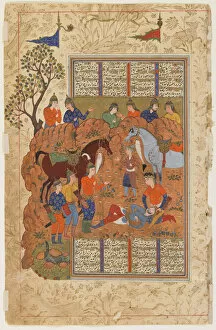Khorasan Collection
"Exploring the Rich History and Legends of Khorasan" Khorasan, a region steeped in ancient tales and historical significance
All Professionally Made to Order for Quick Shipping
"Exploring the Rich History and Legends of Khorasan" Khorasan, a region steeped in ancient tales and historical significance, has captivated generations with its fascinating past. From the epic Shahnama (Book of Kings) to intricate coins portraying mighty kings, Khorasan's heritage is a treasure trove waiting to be discovered. In one legendary tale from the Shahnama, Rustam showcases his indomitable strength as he kicks back a massive rock rolled on him by Bahman. This heroic act symbolizes the resilience and determination that define Khorasan's spirit. The drachms depicting King Mithradates IV, Gotarzes II, Orodes I, Phraate IV, and Mithridates II offer glimpses into the regal history of Khorasan. These intricately crafted coins serve as reminders of the powerful rulers who once governed this land. Among these rulers was King Sapor II whose image adorns a coin from this era. His reign marked an important period for Khorasan as it witnessed significant cultural developments under his rule. Emperor Hadrian also left his mark on Khorasan through a coin bearing his likeness. This serves as evidence of the region's connection to wider empires beyond its borders. Not only known for its historical figures but also for its spiritual traditions, an engraving depicts a traveling Dervis from Khorasan. These wandering mystics played an integral role in spreading wisdom and enlightenment throughout the region. The romantic tale between Kay Kavus and Sudaba further adds to the allure of Khorasan's legends. Their courtship represents love transcending boundaries and reminds us that even amidst power struggles, love can prevail. Iskandar's comforting presence during Darab's final moments highlights compassion amidst turmoil—a testament to humanity’s enduring nature found within these ancient stories. Lastly, Rustam rescuing Bijan from a treacherous pit showcases the hero's unwavering bravery and loyalty.













































